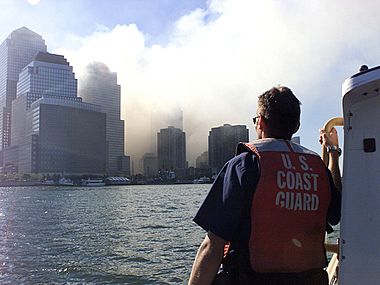Maritime response following the September 11 attacks facts for kids

United States Coast Guard patrolling the New York Harbor with the impact area of World Trade Center in sight, September 11, 2001.
|
|
| Date | September 11, 2001 |
|---|---|
| Location | New York Harbor |
| Also known as | 9/11 Boatlift |
| Type | Emergency evacuation Search and rescue Firefighting |
| Cause | September 11 attacks |
| Organized by | United States Coast Guard |
| Participants | U.S. Coast Guard, FDNY, Sandy Hook pilots, NY Waterway, Circle Line Sightseeing Cruises, Staten Island Ferry, SeaStreak, and other public and private vessels |
| Outcome | More than 500,000 people rescued and evacuated from Lower Manhattan |
On September 11, 2001, a terrible event happened in New York City. After airplanes crashed into the World Trade Center towers, many people in Lower Manhattan needed to get away quickly. However, bridges and tunnels were closed. Public transportation, like subways and buses, also stopped. This left hundreds of thousands of people stranded.
Right after the first plane hit, New York City Fire Department fireboats rushed to the scene. The United States Coast Guard then took charge. They organized a huge group of boats. This included merchant ships, tugboats, and ferries. Their mission was to rescue the people who were stuck and injured.
More than 150 different boats helped that day. About 600 sailors worked together. They evacuated people and brought in important supplies. This massive water rescue is often called the "9/11 Boatlift." It moved over 500,000 people from the island. This was a bigger water evacuation than the famous Dunkirk evacuation in 1940.
Why People Needed Rescue by Water
After the second plane hit the South Tower of the World Trade Center, officials closed all major bridges and tunnels. These crossings usually connect Manhattan to other areas. This meant that people could not leave Lower Manhattan by land. Many tried to walk across bridges like the Brooklyn Bridge. But soon, those were also closed for safety.
As the situation grew more serious, many people headed towards the water. They gathered at the piers along the Hudson River. They hoped to find a way to escape the area. The United States Coast Guard in New York quickly closed the entire New York Harbor to regular ship traffic. This allowed them to focus on the rescue effort.
How the Boatlift Worked
The Coast Guard sent out an urgent radio message. They called for "all available boats" to help. Many different types of vessels responded right away. These included private boats, ferries, and even tugboats. They all worked together to pick up people from the piers. They then carried them across the water to safer locations.
The boats also brought in emergency workers and supplies. Firefighters, police, and medical teams needed to get to the disaster area. The waterways became the main way to move people and equipment. This incredible effort showed amazing teamwork and bravery. It helped save countless lives on a very difficult day.

